Danyang Li
SpotVLM: Cloud-edge Collaborative Real-time VLM based on Context Transfer
Aug 18, 2025Abstract:Vision-Language Models (VLMs) are increasingly deployed in real-time applications such as autonomous driving and human-computer interaction, which demand fast and reliable responses based on accurate perception. To meet these requirements, existing systems commonly employ cloud-edge collaborative architectures, such as partitioned Large Vision-Language Models (LVLMs) or task offloading strategies between Large and Small Vision-Language Models (SVLMs). However, these methods fail to accommodate cloud latency fluctuations and overlook the full potential of delayed but accurate LVLM responses. In this work, we propose a novel cloud-edge collaborative paradigm for VLMs, termed Context Transfer, which treats the delayed outputs of LVLMs as historical context to provide real-time guidance for SVLMs inference. Based on this paradigm, we design SpotVLM, which incorporates both context replacement and visual focus modules to refine historical textual input and enhance visual grounding consistency. Extensive experiments on three real-time vision tasks across four datasets demonstrate the effectiveness of the proposed framework. The new paradigm lays the groundwork for more effective and latency-aware collaboration strategies in future VLM systems.
OpenMoCap: Rethinking Optical Motion Capture under Real-world Occlusion
Aug 18, 2025Abstract:Optical motion capture is a foundational technology driving advancements in cutting-edge fields such as virtual reality and film production. However, system performance suffers severely under large-scale marker occlusions common in real-world applications. An in-depth analysis identifies two primary limitations of current models: (i) the lack of training datasets accurately reflecting realistic marker occlusion patterns, and (ii) the absence of training strategies designed to capture long-range dependencies among markers. To tackle these challenges, we introduce the CMU-Occlu dataset, which incorporates ray tracing techniques to realistically simulate practical marker occlusion patterns. Furthermore, we propose OpenMoCap, a novel motion-solving model designed specifically for robust motion capture in environments with significant occlusions. Leveraging a marker-joint chain inference mechanism, OpenMoCap enables simultaneous optimization and construction of deep constraints between markers and joints. Extensive comparative experiments demonstrate that OpenMoCap consistently outperforms competing methods across diverse scenarios, while the CMU-Occlu dataset opens the door for future studies in robust motion solving. The proposed OpenMoCap is integrated into the MoSen MoCap system for practical deployment. The code is released at: https://github.com/qianchen214/OpenMoCap.
SpecOffload: Unlocking Latent GPU Capacity for LLM Inference on Resource-Constrained Devices
May 15, 2025Abstract:Efficient LLM inference on resource-constrained devices presents significant challenges in compute and memory utilization. Due to limited GPU memory, existing systems offload model weights to CPU memory, incurring substantial I/O overhead between the CPU and GPU. This leads to two major inefficiencies: (1) GPU cores are underutilized, often remaining idle while waiting for data to be loaded; and (2) GPU memory has low impact on performance, as reducing its capacity has minimal effect on overall throughput.In this paper, we propose SpecOffload, a high-throughput inference engine that embeds speculative decoding into offloading. Our key idea is to unlock latent GPU resources for storing and executing a draft model used for speculative decoding, thus accelerating inference at near-zero additional cost. To support this, we carefully orchestrate the interleaved execution of target and draft models in speculative decoding within the offloading pipeline, and propose a planner to manage tensor placement and select optimal parameters. Compared to the best baseline, SpecOffload improves GPU core utilization by 4.49x and boosts inference throughput by 2.54x. Our code is available at https://github.com/MobiSense/SpecOffload .
A Simple Detector with Frame Dynamics is a Strong Tracker
May 08, 2025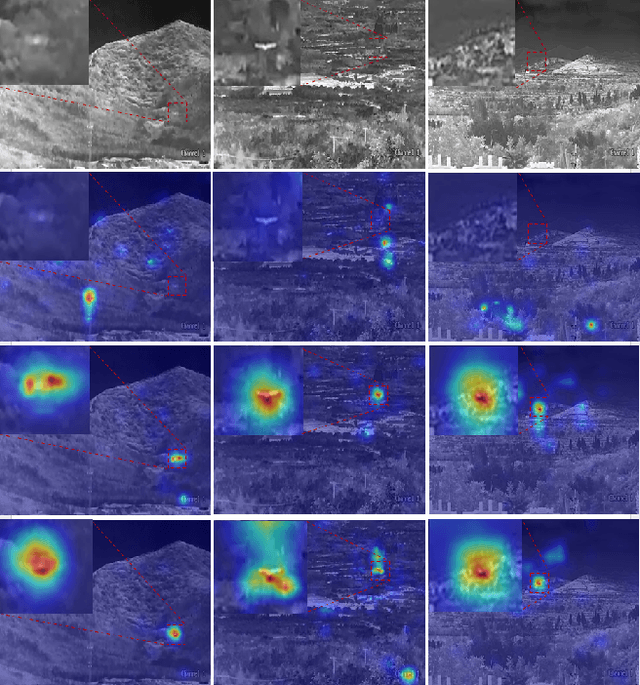
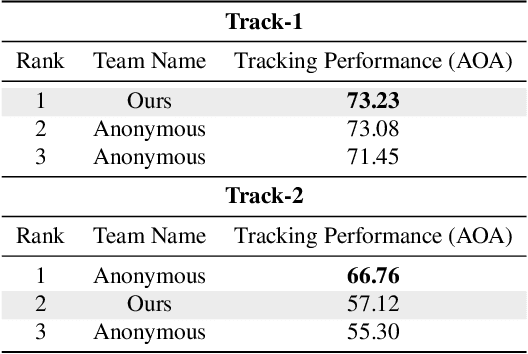

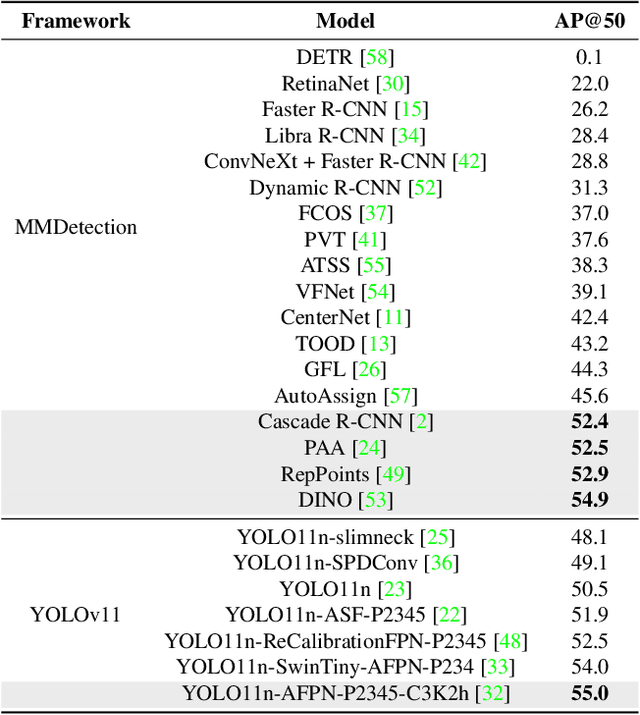
Abstract:Infrared object tracking plays a crucial role in Anti-Unmanned Aerial Vehicle (Anti-UAV) applications. Existing trackers often depend on cropped template regions and have limited motion modeling capabilities, which pose challenges when dealing with tiny targets. To address this, we propose a simple yet effective infrared tiny-object tracker that enhances tracking performance by integrating global detection and motion-aware learning with temporal priors. Our method is based on object detection and achieves significant improvements through two key innovations. First, we introduce frame dynamics, leveraging frame difference and optical flow to encode both prior target features and motion characteristics at the input level, enabling the model to better distinguish the target from background clutter. Second, we propose a trajectory constraint filtering strategy in the post-processing stage, utilizing spatio-temporal priors to suppress false positives and enhance tracking robustness. Extensive experiments show that our method consistently outperforms existing approaches across multiple metrics in challenging infrared UAV tracking scenarios. Notably, we achieve state-of-the-art performance in the 4th Anti-UAV Challenge, securing 1st place in Track 1 and 2nd place in Track 2.
TLINet: Differentiable Neural Network Temporal Logic Inference
May 14, 2024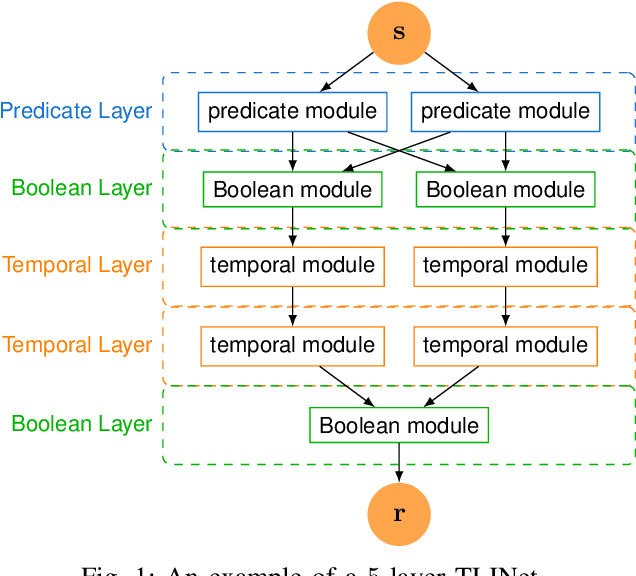
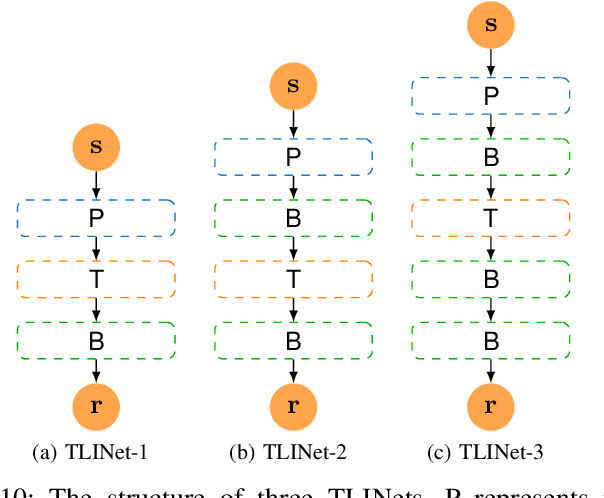
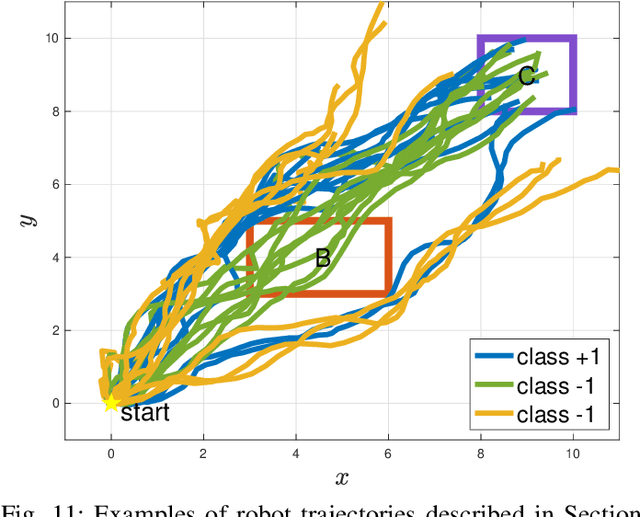
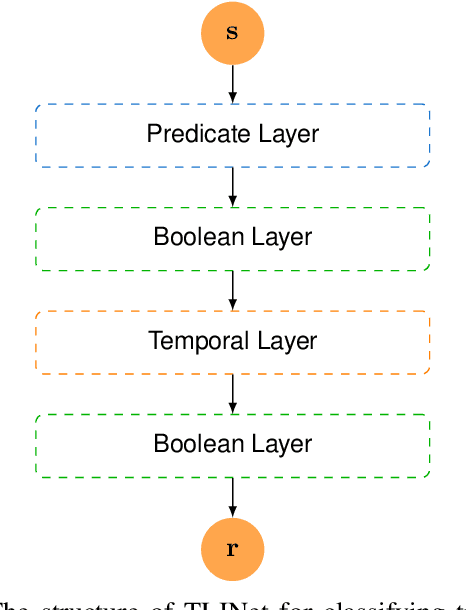
Abstract:There has been a growing interest in extracting formal descriptions of the system behaviors from data. Signal Temporal Logic (STL) is an expressive formal language used to describe spatial-temporal properties with interpretability. This paper introduces TLINet, a neural-symbolic framework for learning STL formulas. The computation in TLINet is differentiable, enabling the usage of off-the-shelf gradient-based tools during the learning process. In contrast to existing approaches, we introduce approximation methods for max operator designed specifically for temporal logic-based gradient techniques, ensuring the correctness of STL satisfaction evaluation. Our framework not only learns the structure but also the parameters of STL formulas, allowing flexible combinations of operators and various logical structures. We validate TLINet against state-of-the-art baselines, demonstrating that our approach outperforms these baselines in terms of interpretability, compactness, rich expressibility, and computational efficiency.
Data Interpreter: An LLM Agent For Data Science
Mar 12, 2024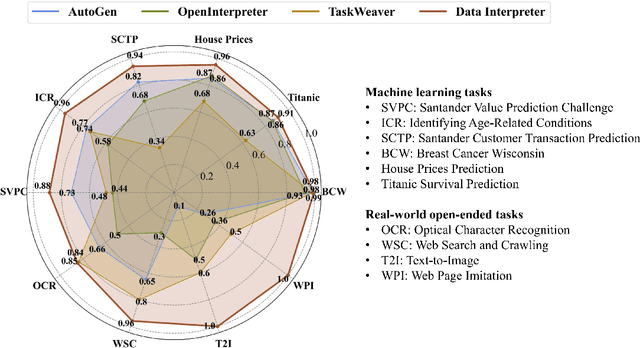

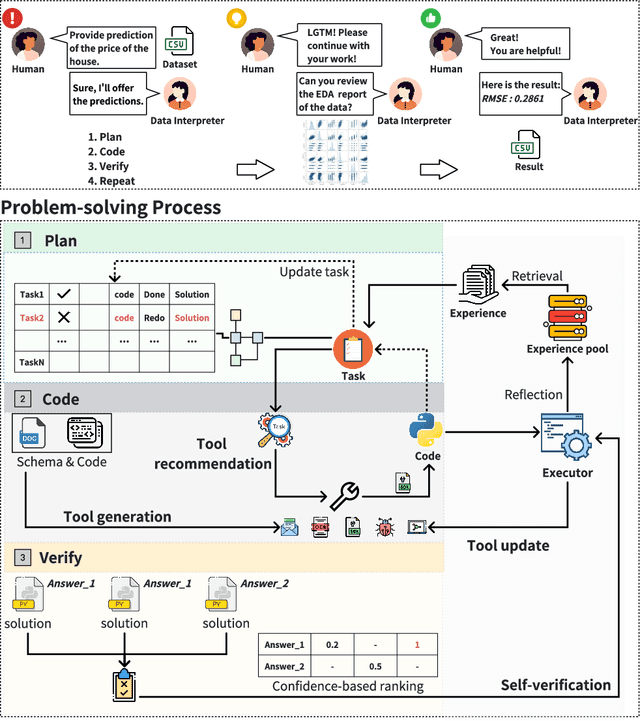

Abstract:Large Language Model (LLM)-based agents have demonstrated remarkable effectiveness. However, their performance can be compromised in data science scenarios that require real-time data adjustment, expertise in optimization due to complex dependencies among various tasks, and the ability to identify logical errors for precise reasoning. In this study, we introduce the Data Interpreter, a solution designed to solve with code that emphasizes three pivotal techniques to augment problem-solving in data science: 1) dynamic planning with hierarchical graph structures for real-time data adaptability;2) tool integration dynamically to enhance code proficiency during execution, enriching the requisite expertise;3) logical inconsistency identification in feedback, and efficiency enhancement through experience recording. We evaluate the Data Interpreter on various data science and real-world tasks. Compared to open-source baselines, it demonstrated superior performance, exhibiting significant improvements in machine learning tasks, increasing from 0.86 to 0.95. Additionally, it showed a 26% increase in the MATH dataset and a remarkable 112% improvement in open-ended tasks. The solution will be released at https://github.com/geekan/MetaGPT.
Multi-class Temporal Logic Neural Networks
Feb 17, 2024Abstract:Time-series data can represent the behaviors of autonomous systems, such as drones and self-driving cars. The problem of binary and multi-class classification has received a lot of attention in this field. Neural networks represent a popular approach to classifying data; However, they lack interpretability, which poses a significant challenge in extracting meaningful information from them. Signal Temporal Logic (STL) is a formalism to describe the properties of timed behaviors. We propose a method that combines all of the above: neural networks that represent STL specifications for multi-class classification of time-series data. We offer two key contributions: 1) We introduce a notion of margin for multi-class classification, and 2) we introduce the use of STL-based attributes for enhancing the interpretability of the results. We evaluate our method on two datasets and compare with state-of-the-art baselines.
Interpretable Generative Adversarial Imitation Learning
Feb 15, 2024

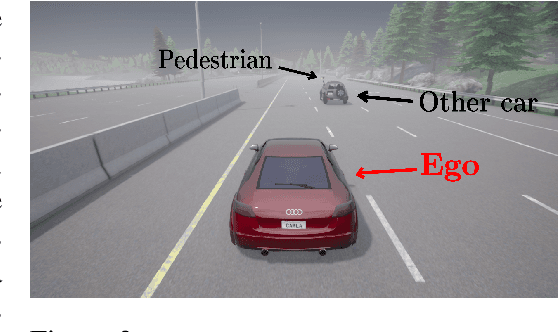

Abstract:Imitation learning methods have demonstrated considerable success in teaching autonomous systems complex tasks through expert demonstrations. However, a limitation of these methods is their lack of interpretability, particularly in understanding the specific task the learning agent aims to accomplish. In this paper, we propose a novel imitation learning method that combines Signal Temporal Logic (STL) inference and control synthesis, enabling the explicit representation of the task as an STL formula. This approach not only provides a clear understanding of the task but also allows for the incorporation of human knowledge and adaptation to new scenarios through manual adjustments of the STL formulae. Additionally, we employ a Generative Adversarial Network (GAN)-inspired training approach for both the inference and the control policy, effectively narrowing the gap between the expert and learned policies. The effectiveness of our algorithm is demonstrated through two case studies, showcasing its practical applicability and adaptability.
Education distillation:getting student models to learn in shcools
Nov 27, 2023Abstract:Knowledge distillation is one of the methods for model compression, and existing knowledge distillation techniques focus on how to improve the distillation algorithm so as to enhance the distillation efficiency. This paper introduces dynamic incremental learning into knowledge distillation and proposes a distillation strategy for education distillation. Specifically, it is proposed to take fragmented student models divided from the complete student model as lower-grade models. As the grade level rises, fragmented student models deepen in conjunction with designed teaching reference layers, while learning and distilling from more teacher models. By moving from lower to higher grades, fragmented student models were gradually integrated into a complete target student model, and the performance of the student models gradually improved from lower to higher grades of the stage. Education distillation strategies combined with distillation algorithms outperform the results of single distillation algorithms on the public dataset CIFAR100,Caltech256, Food-101 dataset.
Learning Signal Temporal Logic through Neural Network for Interpretable Classification
Oct 04, 2022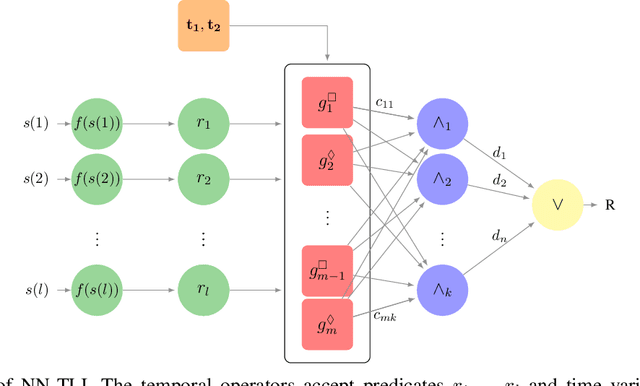
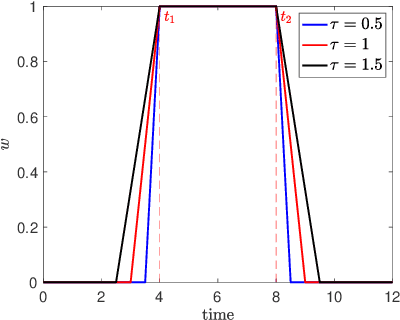

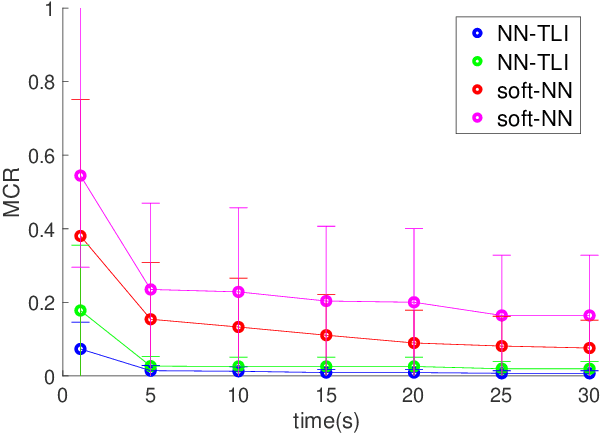
Abstract:Machine learning techniques using neural networks have achieved promising success for time-series data classification. However, the models that they produce are challenging to verify and interpret. In this paper, we propose an explainable neural-symbolic framework for the classification of time-series behaviors. In particular, we use an expressive formal language, namely Signal Temporal Logic (STL), to constrain the search of the computation graph for a neural network. We design a novel time function and sparse softmax function to improve the soundness and precision of the neural-STL framework. As a result, we can efficiently learn a compact STL formula for the classification of time-series data through off-the-shelf gradient-based tools. We demonstrate the computational efficiency, compactness, and interpretability of the proposed method through driving scenarios and naval surveillance case studies, compared with state-of-the-art baselines.
 Add to Chrome
Add to Chrome Add to Firefox
Add to Firefox Add to Edge
Add to Edge